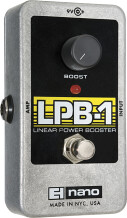View other reviews for this product:
« You get what you pay for! »
Published on 07/30/12 at 08:55This is one simpel pedal without any hazzle. It's small, fits into any tight occupied pedal board, does its job and doesn't cost a fortune. What more do you want?
You get a die cast housing, volume knob, an input and an output jack and finally an on/off switch. It utilizes a red LED light to indicate weather it's on or off. It can run on either a 9 Volt battery or a power supply.
UTILIZATION
Yes, you can ask for more then what you get. First of all the volume knob is so unbelievably sensitive, which makes it hard to dial in the correct amount of boos. You don't know how many dB you boost your signal. In a studio enviroment, somebody might find this info useful - Others would just ignore it.
In the setup I run at the moment, I can't dial up the boost pedal that much. Only a few percent of its total range. This has also made me tape down the button, so that I won't accidentally hit it, while activating the boost.
Some sort of an internal range switch would be nice, in order to keep this problem in check. But for the price range this pedal is in, that wound be an option.
SOUND QUALITY
I've tried this pedal on several amps and with several guitars. When throwing it into the signal chain, I don't notice any high end loss. And there is no need to worry when you hear a slight hiss, when the pedal is cranked all the way up.
You have to be careful where you place the pedal, when you use a solid state amp. If you place in front of the pre-amp you'll only get a gain boost and not a volume boost as such. In order to get the volume boost, you need to place it in the amps effect loop.
I've never had any other clean boost pedals, but I must say that I'm pretty impressed by this EHX.
OVERALL OPINION
This one is build like a brick, doesn't take a lot of space on the pedal board. You have a wide variety of options with it, such as volume unification between several guitar with different output, regaining lost signal strength after a long signal chain or just provide a plain and simple volume boost for a solo.
The different volume pedals doesn't cost that much and de difference between them are minute. So if cost is a factor, you can't go wrong with this one. Should it break, you just go and buy a new one.
Not excellent, but in no way bad as well.
You get a die cast housing, volume knob, an input and an output jack and finally an on/off switch. It utilizes a red LED light to indicate weather it's on or off. It can run on either a 9 Volt battery or a power supply.
UTILIZATION
Yes, you can ask for more then what you get. First of all the volume knob is so unbelievably sensitive, which makes it hard to dial in the correct amount of boos. You don't know how many dB you boost your signal. In a studio enviroment, somebody might find this info useful - Others would just ignore it.
In the setup I run at the moment, I can't dial up the boost pedal that much. Only a few percent of its total range. This has also made me tape down the button, so that I won't accidentally hit it, while activating the boost.
Some sort of an internal range switch would be nice, in order to keep this problem in check. But for the price range this pedal is in, that wound be an option.
SOUND QUALITY
I've tried this pedal on several amps and with several guitars. When throwing it into the signal chain, I don't notice any high end loss. And there is no need to worry when you hear a slight hiss, when the pedal is cranked all the way up.
You have to be careful where you place the pedal, when you use a solid state amp. If you place in front of the pre-amp you'll only get a gain boost and not a volume boost as such. In order to get the volume boost, you need to place it in the amps effect loop.
I've never had any other clean boost pedals, but I must say that I'm pretty impressed by this EHX.
OVERALL OPINION
This one is build like a brick, doesn't take a lot of space on the pedal board. You have a wide variety of options with it, such as volume unification between several guitar with different output, regaining lost signal strength after a long signal chain or just provide a plain and simple volume boost for a solo.
The different volume pedals doesn't cost that much and de difference between them are minute. So if cost is a factor, you can't go wrong with this one. Should it break, you just go and buy a new one.
Not excellent, but in no way bad as well.



